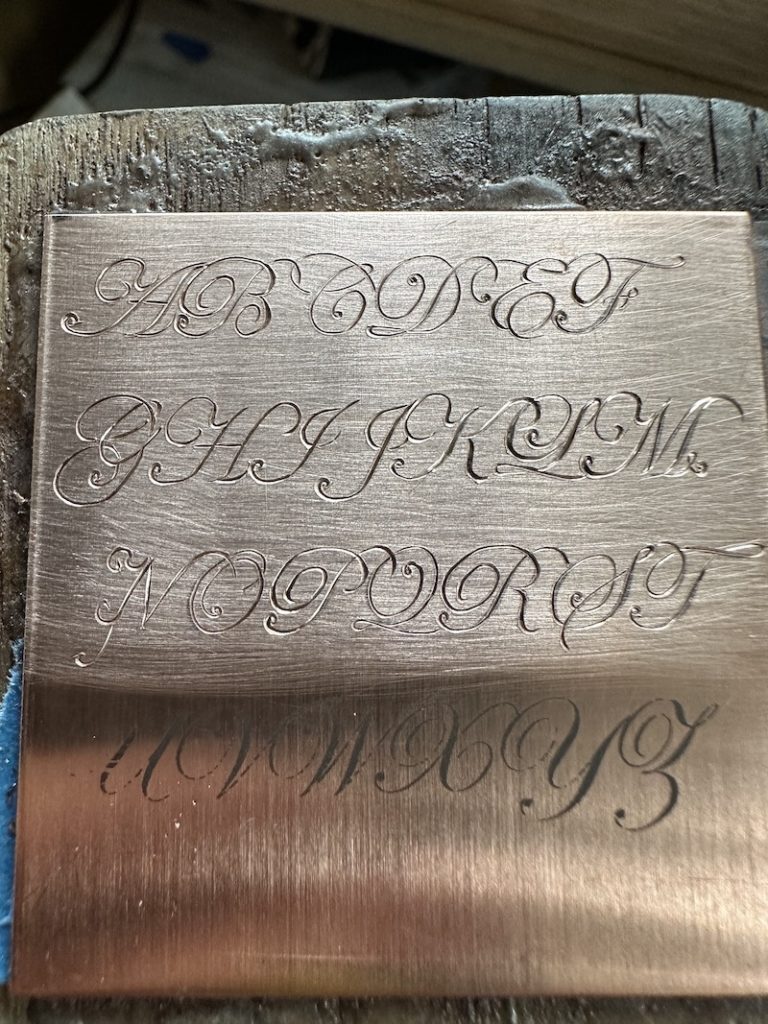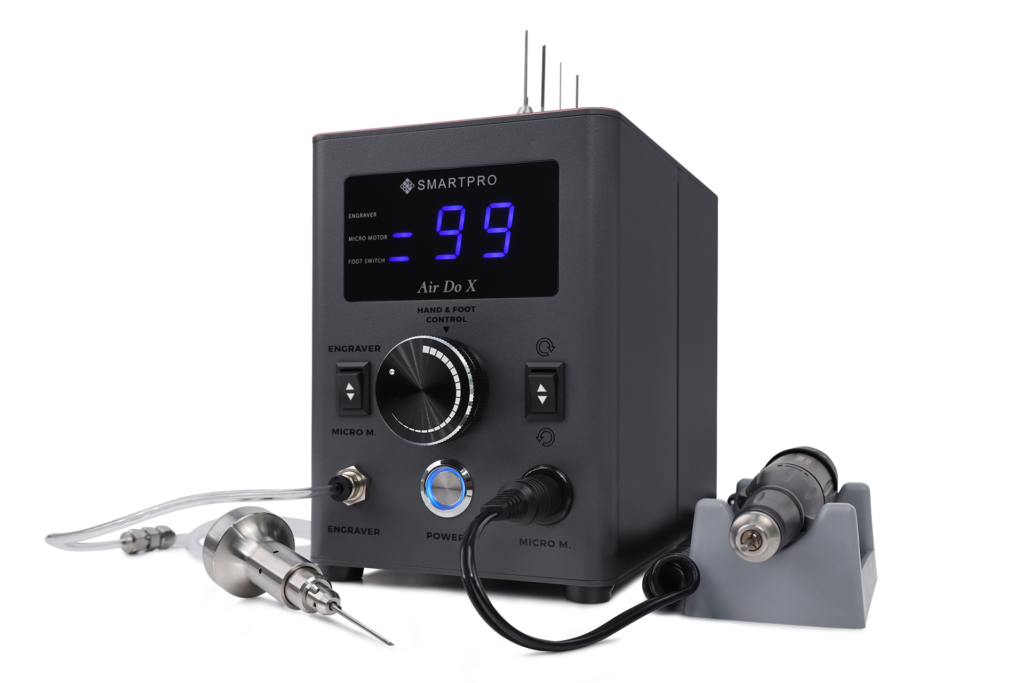Sponsored Content
Double Duty: Testing the Air Do X
Note: This article originally appeared in the November 2023 MJSA Journal, the monthly magazine devoted to professional jewelry making and design. Learn more at MJSA.org.
Melissa Muir
Engraving is one technique that I hear many jewelers say they would like to learn and add to their skillset. The investment costs of a professional engraving system can be one of the first prohibitive setbacks. The second setback is learning the skill of engraving itself.
As a jeweler who is still newly trained in the art of engraving, I can attest that it is the hardest skill I have learned to date. As I began setting up a second studio, the thought of investing thousands of dollars for a second engraving setup was a bit more than I could manage. When attending MJSA Expo in New York City this past spring, I was introduced to the Air Do X by SmartPro Instruments. This machine excited me because not only was it an engraving system, but it also had a built-in micromotor. There is no need for a separate compressor as there is an internal pump built into the machine, making this system extremely quiet, and its small size makes it very portable. And the best part was the price, which at the time of this writing is around $1,100.
About the System
The Air DO X comes ready to use with a brush-type rotary handpiece and cradle for the micromotor, one engraving handpiece with a swappable internal hammer for a lighter or stronger stroke, six quickchange collets and six pre-shaped gravers, a foot pedal that will run both the engraving and micromotor handpieces, and all necessary power cords.
The machine is made by SmartPro Instruments in Thailand. The company has been extremely receptive to user feedback and has made some changes since the product was first launched. There are two handpieces available: a larger one with a harder and stronger stroke and a smaller one with a lighter stroke. Due to this, you will want to check which handpiece comes with the machine when purchasing. Each handpiece comes with a second “hammer” that fits inside the handpiece and can be easily swapped out for lighter or stronger strokes depending on what is desired. Each can be purchased separately.
The machine uses a dial on the front to switch between hand and foot operation and to control the speed for the device beingused. A toggle switch allows you to change between the micromotor and engraving. A second toggle switches the micromotor between forward and reverse. The engraving unit features powerful strokes from 240 to 2,400 SPM. The micromotor tops out at 35,000 RPM. It is easy to see your power and speed settings on the large LED display.
How Well Does It Work?
It seemed too good to be true, so naturally, I had to test it out.
I have tested the Air DO X in many ways. First, I tried the original smaller/softer handpiece. After working with the machine for a while, the smaller handpiece was able to get a nice depth for lettering and general decorative engraving. It is great for shading and bright cutting around bezels and stones. However, it did not have the desired power for background removal and deep engraving.
When using the larger handpiece, I found that it does have the needed power for deeper and wider engraving tasks.
The micromotor works as you would expect. It is vibration-free, fast, and quiet. The micromotor comes with a plastic cradle for storage when not in use. It has a 3/32-inch collet installed for quick-change capabilities.
The speed control can be actuated two ways, either with the foot pedal or with the hand dial on the front of the machine. Switching between the engraver and micromotor is simple with the flip of a switch.
The portability of the machine is fantastic. It has a small footprint—9.5 inches long by 5 inches wide by 7.25 inches high— and is lightweight. The internal pump removes the need for an external compressed air system when engraving.
The system came with six collets and six pre-cut gravers, all of which need to be modified for engraving. I found the shape of the gravers to be more like an onglette graver and more suitable for some stone-setting applications. For my decorative engraving tests, I used some of the gravers from my studio. Collets are available to hold either 1/8 or 3/32 inch gravers.
There is a bit of a learning curve to this machine. It does not have the same power or type of finesse that you might expect from units such as those by GRS, Lindsay, or Enset. At first, I had difficulty controlling the speed. Rather than the gentle purr and smooth movement I am used to, the Air DO X strokes were a bit more forceful and staccato, which can leave small marks or facets in the engraved cut. If the graver is sharpened properly, the “stop and go” marks will be less noticeable. They were most noticeable on tight curves and swirls.
The large handpiece had a strong stroke for digging deep. With any machine, this can bog down the unit, requiring more pressure and torque. When the machine got bogged down, it would slow down and as I applied more pressure to the foot pedal, the speed would lag a little and then all of the sudden take a leap forward with power and speed. This unexpected jump in power sometimes caused the graver to overshoot the area where I was working. The more I worked with this machine, the more I began to get a feel for how to control it. Once you learn how to control the speed and torque, things become much smoother and more consistent.
I did find its capabilities of hammering a heavy bezel (0.8–1.0 mm) quite adequate with the larger handpiece. Bright cutting the edge of the bezel was a dream with the lighter handpiece. In other words, similar to other engraving systems, I would want to have both handpieces. As an engraver and stone setter, I would want the light handpiece for some of the more delicate work such as bright cutting and shading.
For engraving to happen the most important thing to know is how to sharpen the gravers. The collets do not technically fit in the GRS sharpening system, but it was pretty darn close, and I was able to still use it with my GRS Graver Hone and Dual Angle sharpening system. Other methods of sharpening gravers can also be used.
While testing, I used gravers with 90-degree, 120 degree, flat, and onglette shapes. I cut sterling silver, copper, and brass with similar results. At first, I had a lot of noticeable marks inside the cuts themselves. As I became more comfortable with the machine and learned to control it better, those became much lighter and less noticeable. Bright cutting is one of the most difficult skills to master and would show those marks the most, and in the end, I was able to bright cut just as well as with any other system I have used.
The micromotor is a great feature to have built into the same machine. I used it for all sorts of tasks from polishing and drilling to cutting seats for stone setting. I found the torque to be okay for most jobs but did notice that every now and then it would lag or get hung up while drilling into thicker metal. I would prefer it to have more torque.
As I was testing this machine, I was looking for where the machine did well and maybe where it might not compare toother machines on the market. On the microscopic level, the engraving results could be a bit smoother. I found that I had to step away from the microscope and look at the piece with naked eyes. When not put under the microscope, the “tiny facets” from the slower strokes of the engraving machine are not noticeable and the engraving looked great with the right flash of light, depth, and shape.
It is my opinion that this machine is well suited for those wanting to learn to engrave, set stones, and polish their pieces. It is not on the same level as those systems that are more expensive and well known, and there is a bit of a learning curve to handle the slower stroke speed and power. That said, this is a space-saving and budget-friendly option that is both quiet and capable of getting the job done with the right amount of practice to learn the feel of the machine. I felt this system did really well with stonesetting techniques and feel it is a great entry level option for those who are learning to engrave without the large investment and footprint of other systems.
While this may not be my primary machine, it will be put to good use in my own studios. The small footprint, quiet operation, lack of a need for an air compressor, and great portability make it ideal for someone that is on the move, in an apartment, or is tight on space and on a budget. The price point of the Air DO X certainly provides a good option for those just starting out for both a micromotor and engraving system.

Techniques Zone at MJSA Expo, March 10-12, 2024,
at the Javits Center in New York City.
To learn more, go to MJSAExpo.org.
MJSA would like to thank Gesswein for providing the Air DO X for testing.
Note: Melissa Muir will present several demonstrations at the new Tool Testing & Techniques Zone at MJSA Expo, March 10-12, 2024, at the Javits Center in New York City. To learn more, go to MJSAExpo.org.




